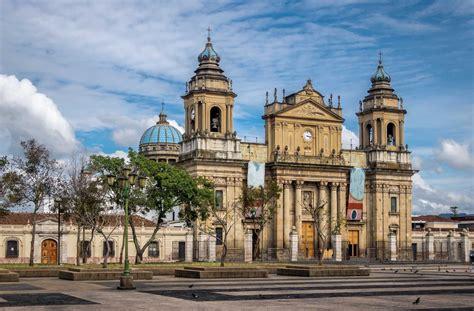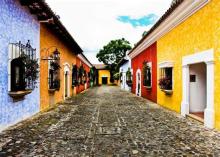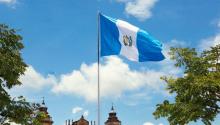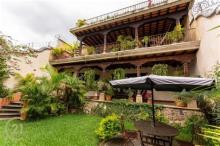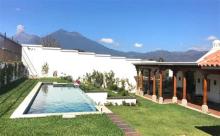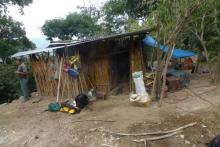Guatemala: Day 8On our very first day of no work, I woke up at the leisurely hour of 9 to the smell of frying baking and percolating coffee, rolled over my mosquito-free enclosure, and let the sweet calls of tropical birds pull towards wakefulness.Just kidding.I got up at 5:15 am with everybody else so we could go on another adventure. Sans breakfast.Now, if you'll recall my mood of the previous day, you might anticipate that I greeted the idea of another adventure with less than my usual vigor. You would be correct. However, I was drug out of my self-pitying bit of wallow by poor Danika. Unbeknown to me, Danika had spent the night suffering from illness that besets quite a few tourists to Central and South American countries and prudently decided that she would be better off spending the morning in bed. After insisting on grabbing her a meager bottle of water (Danika is seriously one of the least demanding sick people I've ever encountered), I stumbled out of the hut and into the van. Our destination this morning was the swamp.Don't get me wrong—it was a <em>mangrove</em> swamp in <em>Central America</em>, but SWAMP was the only thing sticking out to me. According to family dogma, our last name translates to “living by a water willow grove” (again, swamp), but I've just never felt the ancestral pull towards mosquito-ridden, murky, sludgy water in my blood. I honestly wasn't looking forward to it much, except for the promise of a truly glorious sunrise to be seen. When we arrived, our tour guide/swamp captain ushered us into our own cozy little private boat before pushing off with a pole into the black water. Seriously, I must have been extremely tired to not be more freaked out than I was. One of my top 3 least favorite ways to die is death by association with water I can't see through. And the boat was <em>low</em>. It helped when our guide began giving us the spiel about the number of bird species, weasel species and raccoons that inhabited the swamp, but took another downturn when he mentioned the water snakes (one species of which is several feet long) that also inhabit the area. Sep and I both scooted closer together on our bench—she, brave woman, can't even swim. I promised to save her if the boat (oh, let's be honest, glorified kayak) capsized, provided I didn't die of fear first. Thankfully, my mood lightened with the approach of sunrise, and I began to be able to really enjoy the outing. I'm going to include random mangrove swamp details in the “Random Things” section below, so as not to completely destroy the flow of my narrative style.Anyways, we came for the sunrise but mainly missed it (since it is quite fast) because we were busy being entertained with Danielle's steering efforts.<img src='http://www.kaiodee.com/sites/default/files/1608836_10200573221733576_385309440_n.jpg' width=400px /><strong>Not the sunrise, but still an awesome view of swamp and volcanoes in the morning, as well as a boat with some other Americans.</strong> Something about Danielle: Only twice during this entire trip did I manage to be slightly more adventurous than she was. I went deeper into the ocean, and I was more enthusiastic about crocodiles (more details in a future blog). Otherwise, Danielle is that person who always gets to do awesome things because she never hesitates to ask for the opportunity. In this case, she convinced the tour guide she should be in charge of the pole for a while. I envy her this outgoing ability, and have definitely added its acquisition to my life goals.As you might have suspected, the tour guide only made steering <em>look</em> easy. What would have been a relatively smooth, short boat ride turned into a much longer one with much more mention of “Shore. Shore approaching. Do you SEE THE SHORE?!?” to the point that Steve mentioned how Gilligan's Island also began with a “three-hour tour” and Darvy began playing the Titanic theme song on his iPhone.<img src='http://www.kaiodee.com/sites/default/files/1608431_10200572992487845_208917314_n.jpg' width=400px /><strong>Danielle wasn't very amused by “My Heart Will Go On,” but Darvy and I were, so that's okay.</strong>Anyways, we survived the trip and made it back to our starting point, sleepy but happy and ready for breakfast. After breakfast, we all agreed it was naptime, and the rest of the day was taken up with sleep, Nertz, and showers. Then, it was time for one of my favorite parts of the whole, amazing trip. TURTLE TIME.We had dinner at Johnny's Place, and then went about 100 yards down the beach to a turtle conservation site. Basically, the group that runs it will follow female turtle tracks when they come onshore to lay their eggs, and take the eggs back to the secure site before tourists/predators can ruin them. Then, for a small fee they allow tourists to be a part of the baby turtle release at sundown (when it's harder for the predators to see and eat the babies). Turned out one of the guys running the show was none other than our mangrove swamp captain, and because of our volunteer efforts at the spay/neuter clinic allowed us this opportunity for free (although we paid anyway, because who doesn't want to support such a crazy-cool organization?!?). Anyways, they brought out a couple of buckets of 2-hour-old sea turtles and let me tell you, it was one of the cutest things I've ever seen. The turtles apparently know where the ocean is even at that age, and most of them would stay crowded up to the correct edge no matter how the buckets were turned. Drawing a line in the sand, the turtle guys had us stand on one side of it before releasing the turtles, so that we wouldn't accidentally interfere with our progress. Also, we had to start farther away from the waves than I really felt was fair to the tiny things, because apparently that first struggle across the sand imprints the beach on them. This means that when the females are grown, they will come back to this beach to lay their own clutches of eggs, supporting the conservation effort. Isn't that just cool?Anyways, I thought we'd each get to release maybe one baby turtle, but when the time came it was basically a case of putting little turtles on the sand as quickly as possible and then cheering them on as they flippered towards the water. As I mentioned before, the waves on this beach were quite strong, and it was extremely entertaining in an “Oh, you poor little dears” kind of way to watch the waves flip the babies on their backs, leaving tens of little flippers flapping frantically in the surf before they righted themselves and carried on. After about 20 minutes of progress, we watched the last baby disappear into the ocean, for what I've assured my inner 5 year old will be a long and healthy life with plenty of algae to go around.<img src='http://www.kaiodee.com/sites/default/files/69047_10202429984607673_1125441164_n.jpg' width=400px /><img src='http://www.kaiodee.com/sites/default/files/1525354_10202429982847629_138724722_n.jpg' width=400px /><strong>Baby TURTLEs!!! Consider my bucket list shortened.</strong>After the turtles were gone, a wise and enterprising young man with a tray attached to a bicycle came up to us to sell his wares—little turtle scenes made out of local seeds and shells. Let's just say I was an easy mark for that one. It's no wonder he came straight to me.Afterwards, Dr. Diego randomly showed up with another young doctor living in the area, Carmen, and we all went to have drinks at Johnny's Place before Steve and I walked home along the beach (as we were both quite tired). Oh, and Danika did manage to drag herself out of bed to come see the turtles with us. I'm pretty sure she'd have done that no matter how poorly she felt.Random Things:--So, mangrove swamps are freakin' fascinating. They've adapted to live in this watery environment of wide-ranging salinity concentrations, and for a lot of the mangroves their roots actually start high up in the trees and trail into the water.<img src='http://www.kaiodee.com/sites/default/files/th.jpg' width=400px /><strong>Not a picture from our trip, but still a good example.</strong>--Also, the number of herons and kingfishers we got to see was just beautiful. My favorite creature of the swamp, however, was the four-eyed fish.<img src='http://www.kaiodee.com/sites/default/files/1.jpg' width=400px /><strong>Apparently, one set of eyes is to watch for predators above, while the other is to watch for prey below. Random picture from Google, but you get the idea.</strong>These guys, if startled, would get up a good running start and then jump out of the water to bounce along like they were a rock someone had skipped. We'd see whole schools of them, just little heads half-sticking out of the water, turn into these bouncing little fishy projectiles at the smallest provocation. I could have watched them all day. --Another thing we saw a lot of were shrimp- and fish-catching locals. Apparently the shrimp are particularly abundant in these mangrove swamps and have adapted their breeding and egg-laying habits to coincide with the seasonal salinity that best suits them. One man we saw used shrimp as bait to catch fish and, I kid you not, he caught another fish approximately every 15 seconds. Shrimp on hook, drop hook in water for 2 seconds, pull out a fish, remove fish into bucket, and repeat. I'm pretty sure if fishing were always that easy and someone would clean and cook them for me, I could actually get into fishing to.--At one point during the swamp trip, I heard Darvy insert the word “anaconda” into the Spanish conversation he was having with our tour guide. Apparently the look I turned around and gave him was priceless, as he had to stop laughing before explaining to me that he hadn't been discussing actual anacondas in this swamp. If looks could kill...--I would not want to visit Guatemala without a local driver to escort me around. Some of the situations that Darvy calmly guided the van through made me close my eyes and squeeze the arm rest. In one of the poorer villages, Darvy actually hesitated before plunging down the hill to the clinic, and I was fairly convinced we'd never make it out alive.--A lot of the cattle I saw in Guatemala were of the Brahma variety, especially in the swamp. Some cowherds move their cattle onto apparently stable land in the swamp to find the best grazing land.--Also, there were a ton of iguanas. They liked to lay out in the sun on the tops of walls, and would lay very still until they sensed you had a camera out. We had a remarkably difficult time getting a good picture of one.<img src='http://www.kaiodee.com/sites/default/files/1560577_10202429949806803_348987304_n.jpg' width=400px /><strong>Can you even see it? In the shade there?</strong>--When you do as many spays and neuters as we had done that week, you often find yourself in a rather peculiar mindset. There were loads of free-ranging dogs in the Guatemalan communities we visited, and although we still cooed at them first, our next action tended to be to look for testicles, just in case we needed to stop and take those off. No, we didn't just steal random dogs for neuter by force, but it wasn't for lack of speculation. We were always especially happy in the clinics when we were asked to neuter a male who'd previously been used for breeding. Females can produce a good number of puppies a year, but that's nothing compared to how many a male can sire.--During this trip, I repeatedly caught myself thinking that I wouldn't be able to interact with the animals as easily as I could in the U.S. because they wouldn't speak fluent English. Turns out belly rubs are universal.
